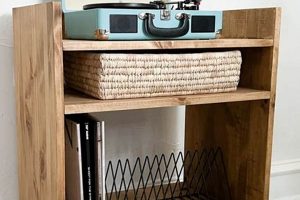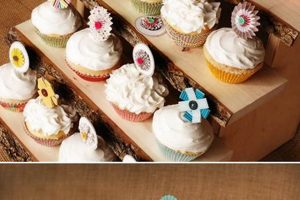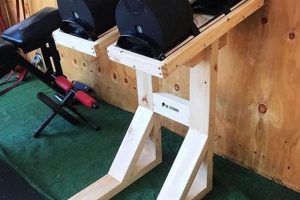A constructed platform for displaying baked goods, assembled from inexpensive materials sourced from discount retail outlets, allows for an elevated presentation without significant financial investment. An example includes combining a glass plate from a dollar store with an inverted candlestick to create a tiered dessert server.
The appeal lies in its affordability and customization potential. Individuals can craft unique serving pieces tailored to specific aesthetics or event themes. Historically, tiered displays have signified importance, and this approach makes that visual emphasis accessible to a broader audience regardless of budget constraints.
The following sections will delve into specific material selections, construction techniques, and design considerations for creating these cost-effective and visually appealing display solutions.
Tips for Assembling Affordable Dessert Platforms
Constructing elevated dessert displays from discount retail materials requires careful planning and execution. These tips offer guidance for ensuring structural integrity and aesthetic appeal.
Tip 1: Material Selection: Prioritize durable adhesives. Epoxy resins or construction-grade adhesives provide superior bonding compared to general-purpose glue, ensuring the assembled structure can withstand the weight of the displayed items.
Tip 2: Surface Preparation: Thoroughly clean all surfaces before bonding. Remove any residue, oils, or coatings that may impede adhesion. Isopropyl alcohol is suitable for cleaning most materials commonly found in discount retailers.
Tip 3: Weight Distribution: Consider weight distribution when selecting components. Choose bases with a wide diameter for enhanced stability and position heavier items closer to the center of the platform to prevent tipping.
Tip 4: Aesthetic Consistency: Maintain aesthetic consistency through cohesive color palettes or thematic elements. Employ paint, decorative paper, or embellishments to unify disparate components into a visually harmonious whole.
Tip 5: Structural Reinforcement: Incorporate internal reinforcement when necessary. Small wooden dowels or metal rods can be discreetly embedded within the structure to increase load-bearing capacity, particularly for multi-tiered designs.
Tip 6: Safety Considerations: Ensure all edges are smooth and free of sharp protrusions. Sanding or filing sharp edges reduces the risk of injury during handling and display.
These guidelines emphasize the importance of careful planning and execution when creating budget-friendly dessert display structures. Adherence to these recommendations promotes both safety and visual appeal.
The subsequent section will explore specific design concepts and inspirational examples for these platforms.
1. Affordability
Affordability serves as the foundational principle driving the utilization of discount retail materials in the construction of dessert display platforms. The financial accessibility inherent in this approach broadens the appeal and feasibility of elevated presentations for a wider range of individuals and events.
- Reduced Material Costs
Sourcing components from discount retail outlets significantly reduces material expenditures compared to purchasing pre-made cake stands or specialized display hardware. This cost reduction allows for allocation of resources towards other event-related expenses or increased production of baked goods.
- Accessibility for Budget-Conscious Consumers
The low financial barrier to entry makes crafting dessert displays accessible to consumers with limited budgets. This democratization of elevated presentation enables individuals and organizations to enhance their events without incurring substantial debt.
- DIY Labor as Cost Offset
The “do-it-yourself” nature of this approach involves personal labor, which effectively offsets manufacturing and retail markups. This substitution of personal effort for monetary expenditure contributes to the overall affordability of the final product.
- Scalability for Large Events
The cost-effectiveness allows for easy scalability. Producing multiple displays for large gatherings remains economically viable. This facilitates cohesive presentation across numerous tables or display areas without exceeding budgetary constraints.
In conclusion, the emphasis on affordability provides a practical and inclusive solution for elevating dessert presentations. By leveraging inexpensive materials and personal labor, this strategy empowers individuals and organizations to achieve aesthetically pleasing results without compromising financial stability.
2. Creative Reuse
Creative reuse forms a cornerstone of the “dollar store diy cake stand” concept, representing the practice of repurposing discarded or readily available items into functional and aesthetically pleasing dessert display platforms. This approach necessitates a shift in perspective, viewing everyday objects not for their intended purpose but for their potential as building blocks in a novel creation. A direct consequence of creative reuse is the reduction of waste, aligning with principles of sustainability. The importance of this component lies in its ability to transform mundane items into elements of visual appeal and practical utility.
The practical significance of understanding the creative reuse aspect is illustrated through numerous examples. A glass plate, originally intended as tableware, can be inverted and adhered to a candlestick or other decorative base to form the platform’s surface. Similarly, decorative bowls, candle holders, or even picture frames can be repurposed as supporting structures. The effectiveness hinges on identifying inherent structural qualities and visual attributes that can be adapted for display purposes. Careful selection and integration of these repurposed elements are crucial for achieving a stable and aesthetically cohesive final product. Consider the alternative of simply purchasing a cake stand. That standard procedure bypasses the benefit of customization and the resourcefulness of minimizing waste.
In summation, creative reuse is more than just a cost-saving measure; it is a design philosophy that encourages resourcefulness, sustainability, and the transformation of ordinary objects into functional art. While challenges may arise in ensuring structural integrity and aesthetic harmony, the principles of creative reuse offer a valuable framework for crafting unique and affordable dessert presentation solutions. This underscores a critical link between economic feasibility and environmental responsibility, making “dollar store diy cake stand” construction a compelling option.
3. Material Compatibility
Material compatibility constitutes a crucial factor in the structural integrity and longevity of any “dollar store diy cake stand.” Incompatible material pairings can lead to adhesive failure, compromised stability, and ultimately, the collapse of the assembled display. The selection of materials for the base, platform, and adhesive must therefore be carefully considered to ensure a durable and safe structure. For instance, attempting to bond a non-porous surface like glass with a water-based glue, typically effective on porous materials like wood, will likely result in a weak and unreliable connection.
Practical application requires understanding the properties of common discount retail materials. Many plastics found in such outlets possess low surface energy, making them difficult to bond with standard adhesives. Surface preparation techniques, such as light abrasion or the use of a primer specifically designed for plastics, become necessary to enhance adhesion. Conversely, porous materials like unfinished wood readily accept many types of adhesives but may require sealing to prevent absorption of moisture from the displayed baked goods. A successful implementation entails selecting adhesives that are chemically compatible with the chosen materials, capable of withstanding anticipated loads, and resistant to environmental factors such as humidity and temperature fluctuations.
In summary, neglecting material compatibility poses a significant risk to the success of a “dollar store diy cake stand” project. While cost savings are a primary motivator, prioritizing appropriate material selection and adhesive choices is paramount to ensuring a safe, stable, and aesthetically pleasing result. Overcoming these challenges requires a basic understanding of material science and adherence to best practices for surface preparation and bonding. The long-term value of the project is directly tied to the initial investment in compatible materials and suitable adhesives.
4. Structural Integrity
Structural integrity is paramount in the construction of any “dollar store diy cake stand.” It directly dictates the load-bearing capacity, stability, and overall safety of the display platform. A failure in structural integrity can result in the collapse of the stand, damaging the displayed items and potentially causing injury. The selection of materials, the design of the structure, and the quality of the assembly techniques directly influence this crucial attribute. Inferior materials, inadequate bonding, or an unbalanced design can compromise the stand’s ability to support the weight it is intended to bear.
The practical implications are evident in several design aspects. For example, a tall, slender stand made from lightweight plastic may be aesthetically appealing, but its narrow base and flexible material may render it unstable, particularly when loaded with a heavy cake. Conversely, a wider base, coupled with a more rigid material like wood or thicker glass, will significantly enhance stability and load-bearing capacity. The choice of adhesive is also critical. A weak or inappropriate adhesive will fail under stress, causing the components to separate and the stand to collapse. The distribution of weight is another key factor; placing heavier items closer to the center of the stand and using a tiered design to distribute the load can improve stability.
In summary, structural integrity is not merely an aesthetic consideration but a fundamental requirement for a functional and safe “dollar store diy cake stand.” While cost savings are a primary motivator for utilizing discount retail materials, neglecting structural integrity can negate any economic benefits and lead to potentially hazardous outcomes. A thorough understanding of basic engineering principles, careful material selection, and meticulous assembly techniques are essential to ensure a structurally sound and reliable display platform. Attention to these factors transforms a collection of inexpensive items into a functional and aesthetically pleasing centerpiece.
5. Design Versatility
Design versatility constitutes a significant advantage of constructing dessert display platforms from discount retail materials. The inherent adaptability of individual components allows for a high degree of customization, enabling the creation of stands tailored to specific themes, color palettes, or event styles. This stands in contrast to pre-fabricated cake stands, which often offer limited design options and may not align with a particular aesthetic vision. The ability to manipulate individual elements, such as plate shapes, base styles, and decorative accents, permits a personalized expression that elevates the overall presentation.
The practical significance of design versatility is evident in its application to various events. For a rustic-themed wedding, a wooden base salvaged from a discount store can be combined with a simple ceramic plate to create a natural and understated cake stand. Conversely, for a modern, minimalist event, a sleek glass plate can be paired with a metallic candlestick base, resulting in a clean and sophisticated display. The adaptability extends to seasonal celebrations, where themed decorations can be easily incorporated into the stand’s design. Furthermore, the low cost of materials allows for experimentation with different design concepts without significant financial risk. Imperfect results become learning opportunities, fostering creativity and refinement in subsequent projects.
In summary, design versatility is a critical element of the “dollar store diy cake stand” concept, offering a level of customization that is often unattainable with commercially produced alternatives. This adaptability empowers individuals to create unique and personalized dessert displays that enhance the aesthetic appeal of any event. While achieving a cohesive and visually pleasing design requires careful planning and execution, the potential for creative expression makes this approach a compelling option for those seeking affordable and personalized presentation solutions. The freedom to adapt and modify designs based on specific needs solidifies the value of this approach.
6. Aesthetic Appeal
Aesthetic appeal serves as a critical determinant in the overall success of a “dollar store diy cake stand.” While affordability and functionality are primary considerations, the visual presentation significantly impacts its perceived value and effectiveness in showcasing desserts. A visually appealing display enhances the perceived quality of the baked goods themselves, creating a more engaging and memorable experience for observers and consumers. Conversely, a poorly designed or executed stand, despite its low cost, can detract from the appeal of even the most meticulously prepared desserts. The incorporation of color theory, proportion, and visual balance contribute to a harmonious and attractive result.
Consider two scenarios: In the first, a basic glass plate and candlestick, both sourced from a discount retailer, are combined without regard to color or style, resulting in a mismatched and visually unappealing presentation. In the second, the same materials are carefully selected to complement the color palette of the desserts, and embellishments such as ribbon or paint are added to create a cohesive and elegant display. The latter demonstrably elevates the perceived value of the baked goods. Practically, this understanding informs the material selection process, prompting attention to color, texture, and form. It also necessitates attention to detail during assembly, ensuring clean lines, secure bonding, and a balanced overall composition.
In summary, aesthetic appeal is not merely an optional element but an integral component of a successful “dollar store diy cake stand.” It influences the perceived quality of the displayed desserts, enhances the overall event presentation, and reflects the creator’s attention to detail. While achieving a high level of aesthetic appeal requires careful planning and execution, the effort invested in visual design contributes significantly to the ultimate impact and value of the display. The challenge lies in maximizing aesthetic impact within the constraints of budget-friendly materials and DIY construction techniques, an effort that proves valuable when executed successfully.
7. Functionality
Functionality represents a core consideration in the design and construction of a “dollar store diy cake stand.” It encompasses the practical aspects of the stand’s purpose, ensuring it effectively fulfills its intended role of supporting and displaying baked goods. Without adequate functionality, the aesthetic appeal and cost-effectiveness become irrelevant, as the stand fails to meet its primary objective.
- Load-Bearing Capacity
The primary function is supporting the weight of the intended baked goods. This requires careful consideration of the materials used and the structural design. For instance, a delicate glass plate supported by a thin plastic candlestick may be unsuitable for a multi-tiered cake. Calculations or estimations of the load are essential to prevent collapse and ensure stability. Practical implications extend to the selection of adhesives, which must be strong enough to withstand the load without detaching.
- Stability and Balance
A stable stand is resistant to tipping or wobbling, ensuring the safe presentation of the displayed items. A wide base provides greater stability than a narrow one. Uneven weight distribution can compromise stability; therefore, heavier items should be placed closer to the center of the stand. Real-world examples include using a heavy ceramic base to counteract the weight of a top-heavy cake or employing a tiered design to distribute the load more evenly.
- Ease of Cleaning and Maintenance
The stand must be easily cleaned and maintained to preserve its appearance and hygiene. Materials that are resistant to staining and easy to wipe down are preferable. Intricate designs with crevices can be challenging to clean, potentially harboring bacteria. Smooth, non-porous surfaces, such as glass or glazed ceramics, are generally easier to maintain than rough or absorbent materials. The choice of adhesives should also consider their resistance to cleaning agents.
- Appropriate Height and Visibility
The height of the stand should elevate the desserts to an appropriate viewing level, enhancing their visibility and making them more appealing. A stand that is too low may be overlooked, while one that is excessively tall may appear unstable or obstruct the view of other items. The optimal height depends on the overall table setting and the size of the displayed desserts. A mid-height stand is often the most versatile, providing adequate elevation without being overly imposing.
The facets of functionality highlight its integral role in the successful implementation of a “dollar store diy cake stand.” Prioritizing these practical considerations ensures that the final product not only looks appealing but also effectively serves its intended purpose. Neglecting functionality in favor of aesthetics or cost-saving measures can undermine the entire project, rendering the stand unusable or even hazardous. Attention to detail in these areas transforms inexpensive materials into a reliable and visually pleasing display platform.
Frequently Asked Questions
The subsequent section addresses common inquiries regarding the creation of elevated dessert displays utilizing materials sourced from discount retail outlets. These questions focus on practical considerations and potential challenges associated with this approach.
Question 1: What types of adhesives are most suitable for bonding materials commonly found at discount retailers?
Epoxy resins and construction-grade adhesives generally provide superior bonding strength for materials such as glass, plastic, and ceramic frequently encountered in discount retail settings. Cyanoacrylate adhesives (super glue) may be effective for small surfaces but are not recommended for load-bearing applications. Thorough surface preparation is essential, regardless of the adhesive chosen.
Question 2: How can the structural integrity of a multi-tiered stand be ensured when using inexpensive materials?
Internal reinforcement, such as wooden dowels or metal rods discreetly embedded within the structure, can significantly increase load-bearing capacity. Weight distribution is also critical; placing heavier items closer to the center of the stand and utilizing wider base supports enhances stability.
Question 3: What surface preparation techniques are recommended for maximizing adhesion to discount retailer plastics?
Light abrasion with fine-grit sandpaper can increase surface area and improve adhesion. Cleaning with isopropyl alcohol removes any residual oils or mold release agents that may inhibit bonding. The application of a primer specifically designed for plastics can further enhance adhesion strength.
Question 4: Are there any specific safety precautions to consider when constructing these displays?
All edges should be smoothed and free of sharp protrusions to prevent injury. Adhesives should be used in well-ventilated areas, and appropriate personal protective equipment, such as gloves and eye protection, should be worn. The assembled stand should be tested for stability before displaying any items.
Question 5: How can aesthetic consistency be achieved when using disparate materials from discount retailers?
A cohesive color palette or thematic element can unify disparate components. Paint, decorative paper, or embellishments can be used to create a visually harmonious whole. Planning the overall design in advance and selecting materials that complement each other is essential.
Question 6: What are the limitations of using discount retail materials for dessert display platforms?
The quality and durability of materials may be lower compared to specialized display hardware. The load-bearing capacity may be limited, and the aesthetic options may be constrained by available inventory. These limitations necessitate careful planning and execution to ensure a safe and visually appealing result.
In conclusion, while discount retail materials offer an affordable option for creating dessert displays, attention to structural integrity, material compatibility, and safety precautions is essential. Careful planning and execution can mitigate the inherent limitations of inexpensive materials.
The following section will explore potential design variations and inspirational examples for these cost-effective display solutions.
Conclusion
“Dollar store diy cake stand” construction offers a cost-effective and customizable approach to dessert presentation. The exploration detailed throughout this article highlights the importance of material compatibility, structural integrity, design versatility, and aesthetic considerations. Balancing affordability with functionality remains crucial for achieving a successful outcome. Creative reuse, careful planning, and meticulous execution are essential to overcome the inherent limitations of inexpensive materials.
The ongoing pursuit of innovative and budget-conscious solutions encourages further investigation into readily available resources. The potential for environmentally responsible practices, coupled with personalized design expression, elevates the significance of this approach beyond mere cost savings. Continued exploration and refinement of techniques within “dollar store diy cake stand” construction promise to unlock new avenues for accessible and visually compelling dessert presentations.







